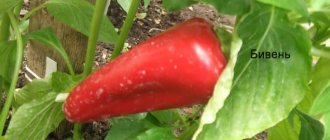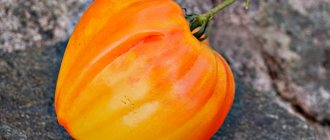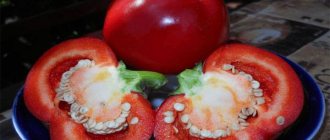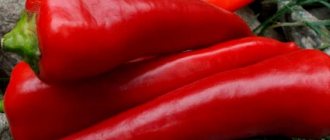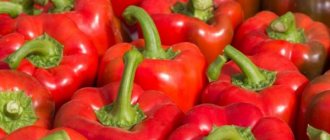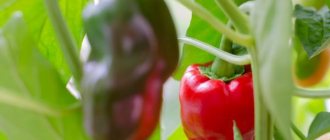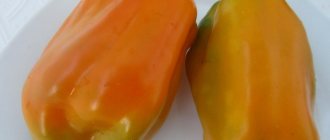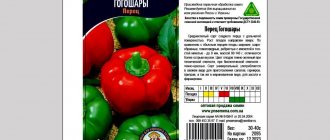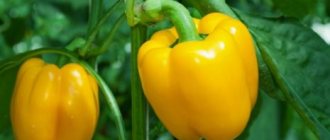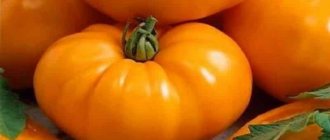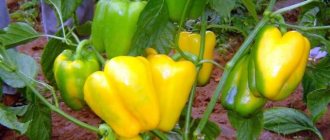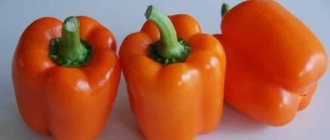Description and characteristics of orange pepper
Orange bell pepper creates a sunny mood both in the garden and on the table, and also brings great benefits to the human body. It contains a lot of nutrients, vitamins and minerals. Compared to other varieties, it has a significantly higher content of potassium, phosphorus and rutin, and in its green form it is an excellent way to prevent cancer and the formation of tumors.
Orange pepper varieties can be super-early, early, mid-season and late. But even the earliest ripening ones have a rather long growing season, so they are grown exclusively by seedlings.
Advice! If you planted late varieties of orange peppers in the garden, and before the end of fruiting the weather became cold, simply transplant them into pots and bring them into the house. Many people even specially plant peppers at a time so that flowering occurs in the open ground, and fruiting continues at home. This way you can enjoy fresh vegetables until the middle of winter.
In fact, experienced gardeners plant peppers of different ripening periods. This allows you to have fresh fruits in the garden throughout the season.
You can grow orange peppers in open ground, in a greenhouse, and even at home on a balcony or windowsill. Information about recommended growing conditions should be indicated on the seed package. After all, pepper intended for growing in a greenhouse will not be able to produce the same yield in open ground.
When choosing varieties, you should also pay attention to the appearance of the potential resident of the personal plot. First of all, this concerns the height and width of the bush. If it is not possible to organize reliable supports, then it is better to give preference to low-growing orange peppers.
Disease resistance is also of great importance. Most varieties of orange peppers on sale today are hybrids and have already been treated against infections and pests.
Characteristics of the Orange species
The Orange Ox sweet pepper is a hybrid variety. In most regions of the country it is grown in greenhouse conditions. In the southern regions, cultivation in open ground is possible.
- The yield of the variety is quite high: from 1 sq. m, gardeners harvest about 10 kg of large peppers.
- The height of the bush, according to the description, does not exceed 1 m. The leaves are green, with frequent veins.
- The average weight of the formed fruit is 200 g. The shape of the fruit is cuboid. Wall thickness is about 10 mm.
When fully ripe, the fruits acquire an orange tint. The taste is rich, sweet and pleasant. Orange Bull pepper is used for preparing salads or canning.
Features of planting and care do not differ from the conditions provided for the red variety. The only addition is the need to harvest on time so that the bush is not damaged by a large number of large and heavy fruits.
Features of choice
Having decided to plant attractive orange peppers in your garden, you need to decide which types are preferable. You should pay attention to the growing conditions, because not all varieties can be grown in unprotected soil or in greenhouses. The maturation period is also important.
Many people buy seeds only of early ripening varieties. But experts advise planting late, early and middle peppers in garden plots. If you listen to the recommendations, pepper can be harvested from the end of June to October. All varieties of orange peppers require plenty of sun, watering and fertilizing. It is advisable to plant them in areas where there are no drafts. You should also focus on the size of the bushes.
Important! When planting seedlings of different varieties, make sure that large plants do not shade short-growing ones, as this will affect the harvest.
Beneficial properties of orange pepper
Orange color indicates a large amount of carotenes. Translated from Latin, this word means “carrot” and indeed, the vegetable got its name precisely for its original shade. Previously, it was believed that it was the carrot that had a beneficial effect on vision and was the leader in the content of substances necessary for this, but after breeders bred the orange bell pepper, it was he who became the winner in this competition.
In addition to carotene, this pepper contains a huge amount of vitamin C. In this regard, it can even surpass lemon! And vitamins of groups A, B, P and E, iron, magnesium, sodium phosphorus and other trace elements make the vegetable a real treasure for every person. It is very important that it does not cause allergies, and due to its low calorie content (26 Kcal per 100 g of product) it does not cause any harm to the figure.
Sweet pepper: testing varieties
. All of them are created for cultivation in open ground in the middle zone, and therefore are very early (ripen 95-100 days after germination) and low-growing. It’s easy to make shelters over them even from plastic bottles. True, the yield is low - up to 10-15 fruits (up to 2 kg) per bush, of satisfactory quality, medium size.
Northern gardeners are trying to solve the problem of slow development and long waits for pepper to bear fruit (up to 5 months!) by searching for ultra-early varieties. I started with the well-known leaders in early ripening: These are, perhaps, the best varieties of sweet peppers. Which one you choose is up to you. Perhaps, after trying some of them, you will choose the one you like the most.. The bushes grow up to 70 cm in height, the fruits are orange-red in color and cone-shaped. The weight of each pepper can reach more than two hundred grams, the wall thickness is 5-6 mm. Highly productive, the fruits are very beautiful and can be used at all stages of ripening. Up to 13-17 fruits can form on a bush. One of the earliest varieties is pepper. Pepper is very demanding of light and heat. Seeds that have been kept in the cold may not sprout; take this into account when storing. Do not store them for a long time - germination is reduced to 30% after 2-3 years of storage. Some varieties like germination temperatures above 30 degrees. The sown seeds must be warm all the time, otherwise they will freeze for a long time. Only a nighttime drop in temperature to 25 degrees is possible.
Purple: Big Daddy, Bagheera.
Photo gallery of pepper varieties
Sweet peppers are sensitive to excess nitrogen. At the same time, the plants quickly develop green mass, but at the same time the number of flowers and ovaries decreases. Novogoshary is a mid-early variety. Its standard plants grow up to 50-60 cm. The red fruits have a characteristic rounded-flattened shape. The weight of juicy, thick-walled fruits (8-11 mm) with proper agricultural technology reaches 120-140 g. The fruiting period of Novy Gosharov is 1.5 months.Snow White is an early ripening variety intended for film shelters. The fruits are cone-shaped, weighing up to 90 g. Wall thickness – 6-7 mm. In technical ripeness, the fruits have a characteristic whitish color, and in biological ripeness - red.CornetIn my opinion, the best of the super early ripening ones are Winnie the PoohBased on 20 years of experience in cultivating sweet peppers in the Moscow region, agronomist Venedikt Dadykin asserts: it succeeds in any year. The main thing is to choose not just “good” varieties, but ones created specifically for our latitudes.YungaEroshka
The best seeds will be full-bodied ones - they will give vigorous shoots. These are peppers whose seeds will settle to the bottom of the cup if you cover them with water. Unviable empty ones float to the surface of the water. This vegetable has an interesting feature. Peppers whose seeds have been stored for a long time lose germination and growth vigor - the sprouts hatch weakly. But the seedlings start growing quickly, and the fertility of such specimens is excellent. Buy seeds from time-tested companies. Orange: Orange Miracle, Siberian Bonus, Ox Ear. In early August, the tops of the stems are pinched and all buds and flowers are removed that will not have time to ripen before the onset of autumn. After 10–15 days, the operation is repeated. During the growing season, tall peppers are tied to stakes or trellises 2-3 times. Among the most common and popular varieties of sweet peppers, one should highlight such as Victoria, Gift of Moldova, Crystal, Rubinovy, Novocherkassky 35, Kolobok, Gogoshary, Yubileiny 307 , Fleshy 7, Lastochka, Donetsk early, Large yellow, Bulgarian 79, Rotunda. Madonna F1 is an early hybrid with cube-shaped fruits. Their weight reaches 200 g. The wall thickness is 6-7 mm. At biological maturity, the fruits are yellow.They also have a high content of vitamins and a shiny dark brown color, rare for peppers.PinocchioandParadox: for some reason, many gardeners stubbornly try to grow varieties of southern origin, and “ancient”:– an early ripening variety of pepper. The bushes grow up to 60 cm, the ripe fruits are red, cone-shaped, the weight of each is about one hundred and eighty grams, the wall is 6-7 mm. The bush can produce 8-15 fruits that have an excellent taste. The variety can be used for compact planting.
supersadovnik.ru
Description of pepper
Hybrid Red bull f1 combines all the best: large fruits, glossy surface, fleshy pulp and versatility in use. The vegetable is grown mainly in the south and central Russia.
Distinctive features
The bushes are tall, reaching a height of 1.5 m. The leaves are of medium size, the color is light green. The hybrid is mid-early and matures in 90–100 days from planting.
When grown in open ground, the seedling method is used. Red bull has high immunity to common crop diseases and insect pests.
The fruits are large, the weight of one varies from 200 to 400 g. The color is deep red, the surface is smooth. The walls are dense, the average thickness is 9 mm, which is why the crop can be stored for 2-3 months without loss of taste.
Up to 9 kg of sweet pepper is harvested from 1 m2. The flesh is crispy and juicy, moderately sweet. Contains many vitamins and is widely used in cooking for preparing vegetable salads, side dishes and winter preparations.
The hybrid variety is characterized by the presence of large-sized fruits. The length of a ripe pepper, resembling an elongated cylinder in shape, reaches 20 cm, the average weight is 200-250, and in some cases - 400 g. The walls of the pepper are thick - about 10 mm. The cavity inside has 3-4 chambers with seeds. Before technical maturity, the color is green; a ripe vegetable is characterized by a bright red color.
The surface of the Bulgarian “handsome” is glossy and covered with delicate and thin skin. The bushes of the crop are spreading and tall, reaching 1 or more meters in height. For this reason, young, well-established plants are formed by pinching the crown of the upper shoot. During the growth of the crop, small stepsons need to be removed, leaving only 5 fruit-bearing branches.
Of the hybrid varieties, the Bull pepper variety has proven itself well. Let's look at the description of the variety in more detail.
Variety varieties
Bull peppers come in black, yellow, orange and red.
All varieties have excellent taste characteristics, thick walls, juiciness and large sizes. Their main feature is that the ovaries form even with minimal lighting. The crop is grown using the seedling method.
Red Bull pepper has distinctive characteristics.
- fully matures in 100 days;
- have a determinate bush (170 cm in height), medium-sized dark green foliage;
- have large fruits: the weight of the formed one can reach 250 g, the length of the ripe vegetable is 21 cm. Red Bull pepper is characterized by a fruit diameter of 6 cm.
- They have a conical shape with an elongated spout at the end. Its inner part contains 4 compartments for storing seeds. The walls of the fruit are dense and thick. The average wall width is 0.7 cm.
As soon as the fruit is fully formed and has gained the required mass, it is harvested. With the onset of technical ripeness, the color of the fruit becomes green; after harvesting, the Red Bull pepper variety turns red in just a few days. On average, the onset of redness is 3-5 days. The taste of the fruit is pleasant, with notes of sweetness.
The Orange Ox sweet pepper is a hybrid variety. In most regions of the country it is grown in greenhouse conditions. In the southern regions, cultivation in open ground is possible.
- The yield of the variety is quite high: from 1 sq. m, gardeners harvest about 10 kg of large peppers.
- The height of the bush, according to the description, does not exceed 1 m. The leaves are green, with frequent veins.
- The average weight of the formed fruit is 200 g. The shape of the fruit is cuboid. Wall thickness is about 10 mm.
When fully ripe, the fruits acquire an orange tint. The taste is rich, sweet and pleasant. Orange Bull pepper is used for preparing salads or canning.
Features of planting and care do not differ from the conditions provided for the red variety. The only addition is the need to harvest on time so that the bush is not damaged by a large number of large and heavy fruits.
- The yellow variety is characterized by large fruits weighing up to 400 g. When the fruit is in the full ripening phase, it acquires a yellow tint. The formation of ovaries and fruits occurs until frost occurs.
- According to the characteristics, the bush reaches a height of 130 cm and is spreading.
The yellow fruits are versatile in use. Caring for the plant and planting seedlings follows the same principle as other types of varieties: they need the same amount of fertilizing, watering and growing conditions.
Landing Features
Bull peppers should be grown using the seedling method. Planting of seeds to obtain seedlings is carried out in early March (if the fruit is grown in open ground). If the goal is to grow a crop in a greenhouse, you can plant the seeds in early February. The seeds are treated in advance with a solution of manganese or aloe to disinfect them from bacteria and increase their germination.
The variety has a high level of sensitivity to the acid-base balance of the soil. To normalize the level of acidity and salts in the soil, you need to add a small amount of lime to it in advance. The optimal level is 15 g per 1.5 kg of soil.
Picking
If the seeds were not planted in separate containers, picking is carried out after 40 days. During this procedure, a substance that accelerates growth is introduced into the root system. This is done so that the bushes develop faster and gain the required height.
Hardening
You also need to carry out hardening measures every day: take the seedlings out into the open air for just a few hours every day. This will allow the seedlings to withstand stressful situations and prevent them from dying from sudden changes in air temperature.
Peppers of the Byk variety are transplanted to a permanent place of cultivation in early May. When planting, adhere to the 50 x 50 cm pattern. After planting, immediately get rid of the side shoots and remove all the lower leaves. This is done so that the bush develops evenly.
Garter
The variety has heavy fruits and tall bushes, so it is important to tie them up. For this purpose, special supports and trellises are used. The stems should not be allowed to break off, otherwise the yield will be significantly reduced.
Rules of care
Watering is carried out in the morning and only with warm water. This allows you to maintain the proper development of the bush and root system, because cold water can lead to rotting of the root system. The sun's rays, combined with moisture, create a dry film on the soil around and allow oxygen to penetrate into the soil.
Top dressing
In order for the yield to be high, fertilizing should be carried out on time. Fertilize three times during the growing season. Each feeding involves the use of a specific solution, but they have one thing in common: at least 1 liter must be poured into each bush.
- The first feeding is carried out 14 days after planting the seedlings in a permanent place. To prepare a solution, dilute 2 tbsp in 10 liters of warm water. l. superphosphate.
- The second feeding is carried out when flowers begin to form. To prepare the solution you will need 10 liters of water, 2 tbsp. l. urea and 2 tbsp. l. potassium phosphate.
- The third feeding is carried out during the formation of the fetus. Dilute 3 tbsp in 10 liters of warm water. l. potassium salt, pour 1.5 liters of prepared liquid into each bush.
Description of the bush
- Before forking, you should always remove leaves as they grow;
- a garter is required;
- It is customary to remove the first bud;
- bushes should receive a lot of light;
- The root system is powerful, but many branches are located close to the surface, so you need to be careful when loosening.
The vegetables of this hybrid are a real source of pride for breeders and summer residents. Sweet pepper “Yellow Bull F1” has very large fruits, a beautiful sunny yellow color. Their weight and dimensions are amazing. The fruits can reach up to 20 cm in length and up to 9-10 cm in cross-sectional width. Inside there are four distinct chambers. Not many seeds.
The thickness of the skin is 9-10 mm, which is very convenient for housewives who make various culinary masterpieces. But more on that later. It is worth noting that, according to reviews from gardeners, the hybrid is very tasty, tender, and sweet. The skin is dense, but not hard. The average fruit weight is 200-250 grams. But summer residents say that with good care you can get 400 grams of peppers. The yield can vary in the greenhouse and in the south - 13-15 kg, in a temperate climate - 7-9 kg.
We suggest you read How to cook gourmet fish in the oven. A simple recipe for preparing Gourmand fish. Marinade for pink salmon |
Maturation
Sweet pepper "Yellow Bull" has a medium or medium-early ripening period. It all depends on the planting location - in warm regions the harvest is always earlier, that is, the timing is mid-early. Other places are closer to average. Conditions in a given year in a particular area, soil fertility, and care also influence.
Galina V., 47 years old, Kaluga region: “The variety grows well and quickly, with almost no fertilizers. To plant it, you do not need to completely dig up the soil; just add a nutrient solution and a little sand. The bushes bear fruit well even in dry years.”
Gennady K., 53 years old, Leningrad region: “I have been growing “Yellow Bull” on my own farm for more than two years. The harvest is always good, but sometimes it is difficult to determine the ripeness of the fruits - they ripen unevenly. I believe that breeders can still work on this hybrid.”
Ekaterina M, 33 years old, Moscow region: “I’ve been growing “Yellow Bull” on my plot for the second year, both times the harvest was good and plentiful. There were almost no problems with the plant, only once after a strong thunderstorm some bushes broke. The variety is perfect for me, as a beginner in vegetable growing.”
When purchasing a variety, you need to pay attention to the company that distributes the seeds. Some subspecies of “Yellow Ox” may be slightly smaller or produce a smaller yield, so you should purchase grains only from trusted agrotechnical companies.
Pepper bushes are gigantic in size - reaching 150cm. The fruits also differ in size:
- The diameter in the maximum cross section is 9 cm. The shape of the fruit is cuboid.
- In the phase of technical ripeness, the color of the fruit is dark green; when fully ripe, it turns red.
- The average weight of peppers is 200-250g. The maximum specimens reach, according to reviews from summer residents, 500g.
- The fruits have a wonderful taste and pleasant aroma.
- The sweet fleshy wall has a thickness of 6-8mm.
- It is used in the preparation of various dishes, in canning and freezing.
- The variety tolerates transportation well and ripens during storage.
Early orange varieties
They say that early varieties of pepper do not have a special taste or smell. Perhaps, but not the representatives of the orange group. All of them are characterized by bright color, thick fleshy juicy walls, increased yield and rich taste.
Let's take a brief look at the most popular early varieties of orange pepper.
Orange Wonder
This hybrid allows you to harvest fruits 100-105 days after the first shoots appear. By this time, the fruits are still green, but already edible. The orange color comes later. The weight of one pepper is 250 g, the wall thickness is approximately one cm.
It is distinguished by increased seed germination. It can be grown in open ground, but the best results are obtained in greenhouses, when placing 3 bushes per meter kV.
The bush reaches a height of one meter, so it needs supports. From one meter kV up to 15 kg of fruit comes out.
It is mainly eaten fresh or as part of salads.
Orange bull
Gardeners fell in love with this orange pepper not only for its early ripening and good germination. Its main advantage is increased productivity. Even in a small area you can grow enough fruit for the whole family.
The fruits are quite large. The weight can be from 200 to 450 g. The shape is slightly elongated. Wall thickness up to one cm.
It can be grown both under film and in open ground. Resistant to diseases and pests, not afraid even of tobacco mosaic viruses.
Used fresh, suitable for freezing and canning, only due to the size of the fruit, they do not fit entirely into a jar, so they have to be cut into pieces.
Kinkan
This hybrid is often chosen as an ornamental plant because of the neat shape of the low bushes and mini-fruits, but their taste is more than decent, so the variety can be called universal.
It can be grown in a greenhouse, in open ground, and at home. Kinkan looks very beautiful when planted in a decorative flower pot. A bush with rich green leaves is abundantly strewn with orange peppers up to 5 cm in size. Peppers are eaten fresh, added to salads, first and second courses, and used for canning.
Orange mini
Another hybrid related to mini peppers. Can also be grown in open and closed conditions. The bush is up to half a meter, lush and covered with fruits weighing up to 35 grams. Resistant to diseases. Loves moisture and warmth, requires increased feeding.
Contains a lot of vitamin C and sugars.
Used for preparing fresh summer dishes, as well as for preservation.
Amber
Technical ripeness of this sweet pepper occurs 110 days after emergence, but by this time the fruits are still green. Only after 2 weeks they will turn deep orange. You can pick them from the bushes green and leave them to ripen at home, only then the color will be more dark yellow than orange.
Peppers are medium in size. They weigh up to 100 grams. The bushes grow up to a meter, so they need a garter.
Use in cooking is universal.
Orange miracle
This hybrid is the most popular among all orange varieties. You can identify it by its brighter color. The harvest can be harvested after 90-95 days. The fruits, weighing up to 250 grams, are cube-shaped and have a very pronounced pleasant taste.
The walls are thick, approximately 7-9 mm. The pulp is juicy. The bush reaches a height of up to a meter, so support is required.
It can be grown in open and closed ground. Needs increased nutrition especially during flowering and fruiting.
It has an attractive appearance, is well stored and can withstand transportation without problems, so it is often grown for sale.
Orange Delight
This early ripening hybrid has a small compact bush and medium-sized fruits. Can be grown in any conditions. Suitable not only for open and closed beds, but also for growing at home on window sills or balconies.
The pepper is very beautiful. Despite its small size, it has very thick walls up to one cm. At the same time, 15-20 fruits can be located on the bush. They change color as they ripen, adding even more charm.
From a meter of kV you can collect 10-15 kg, depending on the stability of environmental conditions and the nutritional value of the soil.
The undoubted advantage of the variety is that even after processing it does not lose its taste and aroma.
It is also popular due to its excellent presentation, shelf life and resistance to transportation even over long distances.
Orange beauty
This hybrid is quite tall. The bush can grow up to a meter and a little higher, but due to the fact that it is a standard bush, it does not require formation. Grows on any type of soil. Yield per meter kW up to 10 kg. It should not be planted too often. There should be no more than 7 bushes per kV meter, otherwise the plants will shade each other.
The harvest can be harvested within 90-95 days after the first shoots. The fruits are large, weighing 210-250 g, very juicy. The taste is sweetish.
The variety is resistant to many diseases, including Verticella wilt.
The early varieties of orange sweet peppers that we have listed are considered the most proven. They produce a good harvest, do not require special care, withstand pest attacks, and are resistant to infections and fungi. But besides this, they have a rich taste and a very pleasant aroma, as well as a huge amount of vitamins.
Pepper "Yellow Bull F1": a variety with many strong qualities
Another type of variety with an average ripening period. Large and beautiful fruits, reaching 200-300 g in weight.
The bush is spreading, medium-sized. The species name of this variety speaks for itself. The fruits are yellow in full ripening.
They can be harvested at technical maturity, when they have gained the required weight of the fruit, but will be green in color. Fruits can set before the onset of cold weather.
They are well preserved and can be used in salads, frozen or when preparing for the winter. Every year, new varieties of pepper appear on sale, so you need to keep an eye on the new products.
Such hybrids have a very wide table application. The crispy skin and juicy flesh are ideal for fresh salads. The bright color of the fruit will add beauty to the winter twists. Due to their thick walls, these are ideal peppers for stuffing. Meals can be perfectly stored in the freezer, which is very convenient.
The fruits are also dried, frozen, and pickled. Many housewives even make juices and sauces. Yellow Ox Bell Peppers are considered one of the best vegetables to use in the kitchen. Also, its use is very beneficial for the health of young children, who are so often allergic to all red fruits; pepper is also suitable for feeding nursing mothers and people in rehabilitation.
You have met a wonderful hybrid. As you can see, there are a lot of advantages, unpretentiousness in cultivation. These indicators increase the chances of pepper becoming an inhabitant of the beds of many gardeners.
Vegetables bring great benefits to our health, which should not be underestimated. They contain a lot of not only vitamins, macro- and microelements, but also fiber, which helps our digestion. Not all vegetables can be eaten with equal pleasure in fresh and processed form, but peppers are ideal for this.
Read also: Tomato Orange, variety description, reviews, photos, characteristics
What types of Bulls are there?
There are several types of this variety on sale: Red Bull, Orange Bull, Yellow Bull. These are ordinary and not quite ordinary varieties.
The fruits are large, with their inherent taste, thick-walled, juicy. The unusual thing is that the fruits set even in a dimly lit place, under growing conditions in a greenhouse.
It is possible to pick them at the stage of technical ripeness, and then they ripen perfectly when picked until they have varietal coloring.
You might be interested in an article about the Bogatyr pepper variety.
You can read about which varieties of thick-walled peppers can be grown in open ground here.
All these peppers are grown using the usual seedling method.
Features of cultivation and care
Recommended timing for planting seeds for Orange Bull seedlings for the middle zone is the first ten days of March. Residents of other regions are guided by the fact that by the time they move to a permanent place, the age of the plants should be 60-70 days.
Peppers are planted in the ground in mid-May - early June. Plants are placed according to a 40 by 60 cm pattern, where the first value is the distance between the rows, the second is between the bushes.
In open ground, peppers are most often planted in one stem; only side shoots and excess leaves are removed up to the first fork. When grown in a greenhouse, the Orange Bull variety can be formed into 2-3 stems. Additionally, plants require garters to supports.
The gardener needs to take into account: the more shoots remain, the smaller the fruits may be, but there will be a lot of them. When formed into 2-3 stems, the plants turn out to be taller, they have fewer ovaries and stems, but the peppers are formed much larger. In any variant, the yield remains the same.
Caring for the crop comes down to traditional activities: regular watering, weeding and loosening. To simplify and make work easier, experienced vegetable growers prefer to mulch the ground around the pepper.
During the season, you can feed plants up to 2-3 times with organic matter or mineral fertilizers.
Other orange varieties
Early varieties of pepper are indispensable for regions with short summers. They produce a harvest already in June. But mid and late varieties can also be grown in parallel to produce crops throughout the season. Therefore, it wouldn’t hurt to briefly familiarize yourself with the best representatives of these categories.
Big gold
The variety belongs to the mid-early variety. Can be grown both under film and in open ground. The fruits contain an increased amount of vitamin C. When biologically ripe, they acquire a rich yellow color with an orange tint. Fruit weight up to 220 g, wall thickness up to 8 mm.
Universal use in cooking. It has a pleasant sweetish taste and a very rich aroma.
Bushes of medium height (up to 75 cm). From a meter kV it is possible to collect up to 7 kg of pepper.
Orange lion
This variety surprises with its unusual combination of small bush height (up to 45 cm) and fairly large bright orange fruits (up to 300 g).
Ripens approximately 120 days after emergence.
A hybrid of this variety was recently developed. Orange lion F1 is intended exclusively for greenhouses, the bushes grow up to a meter, and the fruits are the same size as those of its closest relative.
When choosing between an original and a hybrid, focus on the natural conditions of the region and the place in which you will grow it
Orange classic
Mid-early variety. It ripens in 95-120 days, depending on whether it is grown in open ground or in a greenhouse.
The fruits weigh no more than 100-120 grams. They are distinguished by an interesting cone-shaped shape and upward growth. The bushes are medium spreading, up to 60 cm in height.
In technical ripeness, the fruits are green, and in biological ripeness they are bright orange. Juicy, sweet, meaty. They can be used both fresh and for any culinary recipes.
Chanterelle
This variety of pepper is considered the smallest among orange ones. "Chanterelle" is suitable for growing at home or in a greenhouse. One fruit weighs only 25-35 grams, but is very pleasant to the taste and the aroma is quite rich. From one bush, even when grown on a windowsill, up to 1.2 kg is obtained, and in a greenhouse the figure approximately doubles.
It takes 110 days from the emergence of seedlings to technical ripeness, and 130-135 days to biological ripeness.
Note! Requires mandatory formation of a bush by pinching.
Voivode
The mid-early variety is intended for cultivation in open ground and greenhouses. The bush reaches a height of 65 cm. The fruits in technical ripeness are green and weigh up to 180-200 g, in biological ripeness they are orange and weigh up to 300 g. The pulp is sweet, juicy, aromatic. Wall thickness 6-7 mm.
Productivity is high. From a meter kV comes up to 8-10 kg. In terms of use in cooking, it is universal.
Star of the East orange
This mid-early variety ripens in 115-120 days. Suitable for both open and closed ground. Bush 60-70 cm high, medium spreading. The fruits are yellow-orange, sweet, aromatic. The weight of one is up to 200 g.
It is resistant to viral diseases. If you follow the rules of agricultural technology, you can collect up to 8 kg of fruit per kV meter.
Used fresh, suitable for canning and freezing. Doesn't turn out very well stuffed.
Star of the East tangerine
The hybrid is an early ripening one. The bush reaches a height of 80 cm and needs a garter. The fruits are juicy, fleshy, dark orange in color, cubic in shape, weighing up to 230-250 g.
From a kV meter you can collect up to 7-7.5 kg.
Due to its good presentation, predisposition to long-term storage and endurance even for long-distance transportation, it is often grown for sale.
Universal use in cooking.
Sun
Pepper "Sun" is not tall. The bushes are not spreading; they do not grow higher than 45 cm. The fruits weigh 60-80 grams, have a rich yellow-orange color, thin skin, and a pronounced pleasant taste without bitterness. Can be grown both in open and closed ground.
Refers to mid-season. It takes 115 days to technical maturity, 160 days to biological maturity.
Loves sun rays and high humidity. Resistant to verticillium wilt and fruit rot. Universal use in cooking.
Firefly
The mid-early hybrid was bred exclusively for cultivation in greenhouses. 120-130 days pass from the moment of germination to harvest. The medium-spreading bush reaches a height of 70 cm. The pyramid-shaped fruits weigh approximately 100 grams. The taste is sweetish and the aroma is pronounced. One bush yields up to 1.5-1.7 kg of fruit.
The main difference of the variety is that it is never green. In a state of technical maturity, the fruits are yellow, in biological maturity they are bright orange.
Orange King
A mid-season hybrid matures in 110-130 days. In technical ripeness it is dark green, in biological ripeness it is light orange. The average weight of the fetus is 175-180 g. The taste is pleasant, the aroma is rich.
The plant is of medium height, quite compact. 4-6 kg of fruits are collected from a meter kV.
Designed for growing under film, but if the region has stable weather conditions, it can also be planted in open ground.
Used fresh and for preservation.
Ryzhik
The early-ripening hybrid is intended for cultivation in open and closed ground. The plant is semi-standard. The bush is not formed, only one main stem remains.
The fruits can be harvested 98-105 days after the first shoots appear. The fruit is slightly elongated, weight up to 160 g. The wall is thick, up to 9 mm. The pulp is very aromatic, juicy and sweet. Suitable for all types of recipes.
It bears fruit for a long time; the main thing is to collect ripe peppercorns on time.
Orange anniversary
Early variety. Suitable for open and closed ground. Bushes of medium height.
The fruits are harvested 95-100 days after the first shoots appear. The shape is tomato-shaped, round. Fruit weight 85-90 g. Wall thickness up to cm. The pulp is juicy and sweet.
Suitable for any culinary recipes and simply ideal for stuffing.
Characteristics of the Red species
Red Bull pepper has distinctive characteristics.
- fully matures in 100 days;
- have a determinate bush (170 cm in height), medium-sized dark green foliage;
- have large fruits: the weight of the formed one can reach 250 g, the length of the ripe vegetable is 21 cm. Red Bull pepper is characterized by a fruit diameter of 6 cm.
- They have a conical shape with an elongated spout at the end. Its inner part contains 4 compartments for storing seeds. The walls of the fruit are dense and thick. The average wall width is 0.7 cm.
As soon as the fruit is fully formed and has gained the required mass, it is harvested. With the onset of technical ripeness, the color of the fruit becomes green; after harvesting, the Red Bull pepper variety turns red in just a few days. On average, the onset of redness is 3-5 days. The taste of the fruit is pleasant, with notes of sweetness.
Description of the vegetable
The hybrid variety is characterized by the presence of large fruits. The length of a ripe pepper, resembling an elongated cylinder in shape, reaches 20 cm, the average weight is 200-250, and in some cases - 400 g. The walls of the pepper are thick - about 10 mm. The cavity inside has 3-4 chambers with seeds. Before the onset of technical ripening, the color is green; a ripe vegetable is characterized by a bright red color. The surface of the Bulgarian “handsome” is glossy and covered with delicate and thin skin. The bushes of the crop are spreading and tall, reaching 1 or more meters in height. For this reason, young, well-established plants are formed by pinching the crown of the upper shoot. During the growth of the crop, small stepsons need to be removed, leaving only 5 fruit-bearing branches.
Description of the variety of large-fruited crop
The copyright for the Orange Bull bell pepper belongs to the agricultural company Gavrish. This fact was certified by the State Variety Commission in the selection register in 2012. The variety is approved for planting throughout the country. The growing place is a temporary greenhouse or an open bed on the site.
Attention! The seeds belong to the Russian hero series. The manufacturer's catalog also includes Red Bull pepper with similar characteristics.
The fruits of this variety are large, slightly elongated cubes. Some specimens from the greenhouse harvest reach 20 cm and a weight of 400 g (with proper formation of the bush). On average, the peppers are smaller, but the plant's productivity is still at a high level. The fruits consist of 3-4 nests. They have thick walls. The largest ones have up to 1 cm, on average 6-8 mm.
The peppers are forming drooping. At technical ripeness they are green. Later the color becomes bright orange (as in the photo). The “bull” bush has a strong main stem. It actively branches throughout the growing season. Medium sized leaf.
| Type of growth, bush height | Semi-standard, 0.8-1.1 m |
| Ripe fruit color | Orange |
| Planting scheme | 40x60 cm |
| Weight, length and shape of the fruit | About 250 g, 10-15 cm, cuboid |
| Ripening period, yield | Early ripening (100-110 days). In a greenhouse - up to 10-14 kg/m2. In exhaust gas - about 7-10 kg/m2 |
| Drop off point | exhaust gas/greenhouse/greenhouse |
| Diseases | Resistant to TMV |
| By type of use | Universal |
| Flowering type | No data available |
Rules for growing orange peppers
The agricultural technology for growing orange sweet peppers is similar to other varieties. It is also planted for seedlings in mid-February-early March. After the appearance of two true leaves, a dive is carried out, root feeding is carried out, and two weeks later, foliar feeding is carried out. Before planting in the garden, hardening is necessary. But there are also nuances that must be taken into account in order to get a good harvest.
Orange peppers are considered sissies and indeed, this crop is quite demanding, primarily regarding air temperature. If the nights are cool, be sure to use shelter and avoid drafts while growing seedlings. Humidity is of great importance. Overdrying the soil or air can lead to disease and even death of plants.
It wouldn’t hurt to provide additional protection to the root system. The main recommendation for this is to plant the seeds not in a common container, but immediately in separate cups. It’s very good if you can use peat ones. Then the sprout, ready to move into the ground, can be planted in the hole directly in it and significantly reduce possible damage.
Important! Most varieties of orange peppers are hybrids that have already been treated for pests and diseases.
If you take additional measures yourself, the seeds may simply die. Some varieties are allowed to be picked at the moment of technical maturity and left to ripen. But it should be understood that fruits can acquire the maximum amount of useful substances only in natural conditions and only when they receive sufficient amounts of light, heat, moisture and vital juices from the soil.
Seedlings from seeds
You can get the maximum yield if you comply with the established agrotechnical growing conditions. It is best to sow Red Bull F1 pepper seeds for seedlings in March.
Disinfecting seeds in potassium permanganate helps prevent possible bacterial and viral infections. You should make a 2% solution and soak the seeds for 20 minutes. After disinfection, they are washed with cold water.
Seeds are sown in nutritious loose soil. You can make it yourself by mixing ordinary garden soil with sawdust, humus and peat. But sawdust should be pre-treated with urea. You can buy soil suitable for growing seeds in the store.
Warning! The soil is watered as it dries. The soil should not be allowed to become waterlogged or dry out; this has a bad effect on the development of young plants.
For the full development of seedlings, fertilizing is required. Plants should be fertilized every 2 weeks. Nitrogen and potassium complexes are used. Agronomists recommend spraying plants with Epin solution once every 10 days. It prevents possible problems due to low light. Potassium guamate, a root formation stimulator, is also used: for watering, a solution is made of 25 ml of concentrate and 10 liters of water.
When growing Red Bull pepper seedlings, it is recommended to immediately sow the seeds in individual containers. The plant does not tolerate picking well, because the root system of peppers does not recover well. The absence of picking allows you to reduce the time of growing seedlings by 15 days.
Fruit characteristics
Sweet bell peppers are part of everyone's diet. Even people prone to allergies can eat these vegetables, but only with yellow or orange skin. Today we will introduce you to just such a variety. He has proven himself and always shows excellent results. We will talk about the “Bychok” pepper, let’s get to know it based on the characteristics and description of the variety, reviews from summer residents, and look at the photos. In the section on growing and care, you will learn all the main secrets of getting a good harvest.
general information
The variety was bred in our country and is included in the State Register. It is quite popular as it shows good results in greenhouses and outdoors. Growing involves some nuances, but they are all easily doable. Summer residents appreciate Bychok for its taste, productivity, and versatility.
The fruits, as can be seen in the photo, are orange in color. These varieties of pepper have a richer vitamin composition than red varieties. The latter can cause allergies in some people. This does not happen with yellow-orange vegetables. The variety can be consumed during a diet, in the postoperative period, and given to young children. “Bychok” is perfectly stored and can be kept in the freezer all year round; it can also be dried and used as a seasoning.
Distinctive features
Gardeners who are attracted to large peppers often pay attention to the Red Bull hybrid. It not only looks attractive in the garden, surprising many with its size, but also has excellent taste characteristics. Reviews from summer residents confirm that caring for the Red Bull is easy.
Description
Many home garden owners are afraid to buy seeds of large peppers, worrying about possible difficulties during care. The Red Bull pepper differs from many types in that almost no one has any difficulties growing it.
Red Bull pepper bears fruit when grown in greenhouse conditions and in unprotected soil. But without film coverings it is better to grow it only in the southern regions. Agronomists recommend planting seedlings in the ground; according to experts, this way you can get the maximum yield.
The hybrid is tall. Plants grow up to 1.5 m in height and must be tied up. After all, under the weight of heavy large fruits, they can break or fall.
Description of the Red Bull pepper:
- the yield per 1 m2 reaches 9 kg;
- early-middle period of maturation;
- fruits set even in winter greenhouses in low light conditions;
- genetic resistance to potato virus and tobacco mosaic virus;
- The foliage is lush and dark green.
From the moment mass seed sprouts appear to technically ripe fruits, at least 95 days pass. It takes longer to fully ripen, but experts advise picking the fruits without waiting for them to turn red.
By the time they reach biological maturity, there is a risk that the plants will not support the weight of the Red Bull peppers. Reviews with photos confirm that the collected green fruits acquire a rich red color within 4-5 days of storage.
After looking at the photo of the Red Bull pepper and reading reviews about the hybrid, many summer residents cannot wait for the moment when their fruits are fully formed.
- pepper length is 20 cm (some specimens grow up to 30 cm);
- weight 200-250 g (reviews confirm that if agrotechnical conditions are observed, you can get fruits weighing up to 400 g);
- color rich bright red;
- glossy surface;
- the peel is tender, thin;
- the pulp is aromatic, dense, juicy;
- walls 10 mm thick;
- cube-shaped;
- in the internal cavity there are 3-4 chambers;
- the number of seeds is small.
This description attracts many summer residents who like to see interesting large-fruited peppers in their garden beds.
Red bull can be consumed fresh; it is also used for freezing, heat treatment, and canning. It is suitable for inclusion in the diet of young children and people with diabetes. Pepper is considered a storehouse of vitamins B, C, PP and minerals.
Seedlings from seeds
You can get the maximum yield if you comply with the established agrotechnical growing conditions. It is best to sow Red Bull F1 pepper seeds for seedlings in March.
Disinfecting seeds in potassium permanganate helps prevent possible bacterial and viral infections. You should make a 2% solution and soak the seeds for 20 minutes. After disinfection, they are washed with cold water.
You can ensure 100% germination if you pre-germinate the seeds. To do this, they are placed in a damp cloth or gauze for 3-5 days and wrapped in polyethylene to retain moisture. The optimal temperature for germination is 24-27 0 C.
Seeds are sown in nutritious loose soil. You can make it yourself by mixing ordinary garden soil with sawdust, humus and peat. But sawdust should be pre-treated with urea. You can buy soil suitable for growing seeds in the store.
After emergence of seedlings, the temperature is lowered to 20 0 C for 2-3 days. Then it is raised again to 22-25 0 C. Using artificial intense light, it is necessary to provide the seedlings with 12 hours of daylight. After the specified period of time, the seedlings are covered with light-impervious material. Excessive illumination leads to stretching of seedlings and reduced yield.
For the full development of seedlings, fertilizing is required. Plants should be fertilized every 2 weeks. Nitrogen and potassium complexes are used. Agronomists recommend spraying plants with Epin solution once every 10 days. It prevents possible problems due to low light. Potassium guamate, a root formation stimulator, is also used: for watering, a solution is made of 25 ml of concentrate and 10 liters of water.
When growing Red Bull pepper seedlings, it is recommended to immediately sow the seeds in individual containers. The plant does not tolerate picking well, because the root system of peppers does not recover well. The absence of picking allows you to reduce the time of growing seedlings by 15 days.
Pepper cultivation
The grown plants are transplanted into the ground at the age of 50-65 days. They are planted in greenhouses and under film shelters in May. The timing of transplantation into open ground depends on the growing region. The optimal period is early June, but Red Bull peppers in the south can be grown in unprotected soil from mid-May. A prerequisite is the absence of frost and warming of the soil to 15 0 C at a depth of 10 cm.
The survival rate of seedlings can be improved by abundantly watering the holes with hot water. When replanting, care must be taken to ensure that the root system is not damaged. Therefore, experts advise transshipment of plants: they are planted in holes along with the soil in which they grew.
You can adjust the height of plants by pinching the top of the top shoot. The bushes of the Red Bull hybrid are large and spreading. To ensure that plants have the strength to form large fruits, it is advisable to limit their growth. You can increase the yield and size of peppers by pinching the plants. You need to leave 5-6 branches that will bear fruit. The remaining shoots are removed.
Plant feeding is mandatory. During the entire growing period, after moving the seedlings into the ground, this is done 3-4 times. Add superphosphate, wood ash, and potassium chloride. During the period of fruit formation, a solution of bird droppings and mullein is used. At the beginning of fruiting, you can add ammonium nitrate.
One of the mandatory conditions for growing is periodic weeding and loosening of the soil. It should be remembered that plant roots are close to the surface, so deep loosening is undesirable. If you dig deeper into the soil than 5 cm, you can damage them.
Mulching allows you to prevent the appearance of weeds, rapid drying out of the soil and avoid the need for constant loosening of the soil. Straw, sawdust, and seed husks are laid out around the bushes.
You can learn about the peculiarities of growing Red Bull pepper from the description of the variety. It says that with active fruiting, more than 20 large fruits can form on each bush at the same time. Therefore, gartering bushes is mandatory. The easiest way to do this is to use a trellis.
In greenhouses, with timely fertilizing, ventilation and compliance with the thermal regime, the harvest reaches 12 kg per square meter, some manage to harvest even 15 kg. But you can’t count on a record harvest if nightshade crops (potatoes, eggplants, tomatoes) grew in the soil in front of the peppers.
The main requirement is a sufficient amount of light and heat. Lack of light for seedlings leads to weak flowering and poor fruit set, and the stems become fragile. As a result, we get very low yields.
We invite you to familiarize yourself with Popular winter varieties of apple trees
To fully develop, pepper seedlings need to receive light for about 12 hours a day.
The “Yellow Bull” pepper is very heat-loving and can also tolerate heat above 30°C, but it will only grow stunted and the flowers will not be pollinated and will fall out. And if some fruits set, they will be small and curved. Optimal temperatures:
- 20-25°C - for seedlings.
- 17-22°C - for an adult plant.
Pepper needs watering infrequently, but should be plentiful. It consumes the most water during fruiting, which is practically the entire life cycle. Drying out the soil even for a short time leads to the falling of buds and a decrease in yield.
Among soils, pepper prefers black soil with a good humus content. It improves fruiting after organic fertilizing and foliar fertilizing with microfertilizers. But excess nitrogen in the soil only leads to an increase in the vegetative mass of the plant and to a deterioration in the quality of the fruit.
"Yellow Bull" is a hybrid. It was obtained by domestic breeders by crossing two varieties of pepper. The “calling card” of the variety is considered to be a huge fruit: the length of the vegetable reaches 20 cm, in cross section the diameter is 8 cm. The pulp of the “Yellow Bull” is very thick - 10 mm. The average weight of a vegetable varies from 200 to 250 g.
Particularly large fruits can weigh up to 400 g. Their skin is thin, delicate, and the surface is glossy. The vegetable has the shape of a truncated cone, with three to four clearly defined edges and a depressed stalk. During the growth period, the fruits are colored green, and upon reaching technical ripeness their color becomes golden yellow.
Distinctive features
Productivity
This vegetable crop can produce up to nine kilograms of juicy fruit from one square meter. Many of those who have tried to grow this red pepper leave their reviews for those who are encountering this plant for the first time. Therefore, it is worth listening to the opinion of experienced gardeners who believe that it is better to harvest the crop at the stage of technical ripeness, when the color of the fruit is light green. Otherwise, the bushes may not be able to withstand a sufficiently large load, which further increases the risk of pest damage to the plant. And the fruits will ripen to a juicy red color, indicating biological ripeness, during storage.
Sowing seeds
Reviews about this plant are mostly positive. Therefore, in almost every second plot you can see bushes of this vigorous, indeterminate vegetable crop. However, in order to get a good harvest, certain agrotechnical conditions must be observed, and first of all this applies to seedlings. To get rid of a viral or fungal infection, before planting, the seeds must be pickled in a two percent solution of potassium permanganate for twenty minutes at room temperature. Then they need to be washed in cold water. To speed up germination, many people soak them in nutrient solutions. Afterwards, the seeds should be wrapped in a damp cloth for two days and placed in a plastic bag so that they do not dry out. The optimal temperature for the germination of red bull pepper is considered to be between 22 and 24 degrees Celsius. In the middle zone of our country, the best time for sowing seeds for seedlings is the end of February - the beginning of March.
Agrotechnical features
Peppers need to be grown using the seedling method. The seed manufacturer recommends following these principles:
- germinate seeds at a temperature of 26 - 28 degrees;
- do not transplant seedlings into beds until they are 65–70 days old;
- pick the pepper after the second strong leaf appears;
- Gradually remove all shoots up to the first fork;
- strengthen each bush with a support or tie it up;
- feed the crop at least 2 times during the entire period of formation.
Sowing seeds for seedlings | Planting seedlings in a greenhouse/greenhouse | Planting seedlings in exhaust gas | Stepsoning | Harvesting |
| March | May | The end of May | Elimination of sprouts before the first fork, formation of 2 main stems | Since July |
| *dates are indicated for central Russia | ||||
- Seed preparation. The seedling method is used for planting the plant. Seeds are sown in March. Before planting, seed material must be prepared. To do this, the seeds need to be placed in damp gauze, and the temperature must be within 26 degrees. Within a week they will begin to hatch.
- Soil preparation. To plant seeds, you need to prepare the soil. First you need to make a nutrient mixture: soil from the site, peat, humus, sawdust. Mix the mixture well and pour into plastic cups. In addition, peat pots are excellent for planting. If you don’t want to prepare the soil yourself, you can buy it at a specialized store.
Seedlings should be prepared in March. This is done according to the proposed schedule. You can pick a sprout if there is at least one true leaf. When planting in the soil, immediately install a support next to the plant.
Attention! Without active formation, the bush will be taller and produce smaller fruits. But its overall yield will remain the same.
Sowing seeds for seedlings | Planting seedlings in a greenhouse/greenhouse | Planting seedlings in exhaust gas | Stepsoning |
Bell pepper colors: what do they mean?
The red color of the pepper makes it clear that it contains the largest amount of vitamin C and A, and it has the sweetest taste.
The red color in this case is not a warning of danger, like a traffic signal. Quite the opposite: the bright, scarlet color emphasizes that this pepper is the most medicinal member of the nightshade family. It monitors eye health, makes capillaries elastic, and prevents the development of cancer. Yellow peppers contain the least amount of vitamin C than their “brothers” of other colors. The value of such a fruit lies in trace elements, especially potassium, which is responsible for the health of the cardiovascular system. A lack of potassium can lead to the development of diseases of the nervous system, so you should not completely exclude yellow peppers from your diet. Green vegetables are the lowest in calories, so they are suitable for people on a diet. It is also recommended for diabetics to consume green peppers, as their pulp contains less sugar. The most useful are bell peppers that are red and orange in color. A lot is known about red pepper, since the scarlet varieties are the most popular among vegetable lovers.
The orange fruit remains a mystery to many, and people buy it more for its unusual color than for its beneficial properties.
Transplantation into open ground
Before transplanting seedlings into open soil, the sprouts are hardened, that is, taken out into fresh air 2 weeks before transplantation. First for an hour, then for 2-3 hours and so on.
Landing
In the autumn season, add organic fertilizers in the form of humus or peat to the soil. Pay special attention to the acidity of the soil; it should not be too low (about 3-4%). Otherwise, you will have to add lime.
Transplant the finished seedlings when they have fully formed 5 leaves, reaching a height of 15 cm. Transplant the plants into the greenhouse according to the 0.5 * 0.5 m pattern. Immediately take care of supports for tying up the plants. Leave approximately 0.6 m in open soil, 0.4 m between depressions. Also prepare supports.
Garter
Rigid supports are necessary for this variety of sweet pepper, as the plants grow tall and need something to rest on.
The Orange Miracle pepper does not need any shaping.
Watering
Watering is the most important point in caring for peppers. It is necessary to regularly monitor soil moisture to prevent rotting of the root system. Add water once every 3 days and do it only in the morning or evening. Otherwise, the water will evaporate too quickly.
Bell pepper Orange miracle, grown in a greenhouse, needs regular spraying of the foliage. Since dry air prevents the plant from fully forming ovaries and fruits.
Mulching and loosening
After abundant watering of the pepper, it is necessary to remove all excess weeds and loosen the soil. Mulch is very important; use peat, straw or sawdust as mulching material.
You can learn everything about mulching the soil from this article.
Top dressing
Fertilization is standard for all varieties of pepper and is carried out 3 times during the growing season:
- During the formation of the first shoots. Add phosphorus microelements that accelerate the growth and development of pepper. Read more about feeding pepper seedlings on the pages of our website.
- During the period of ovary formation. It consists of potassium fertilizers, which help speed up the process of their formation.
- During the fruiting period. Fertilizers consist of calcium and nitrogen, thanks to them the size of the fruit increases significantly and the ripening process accelerates.
